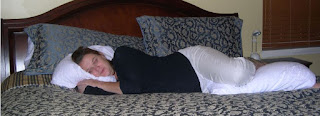Research shows that relaxation during labor and birth allows
for a dramatic reduction in the stress reaction. When subjected to stress (of any kind) or
fear, be it real or anticipated, body changes take place that trigger a defense
mechanism and institutes the fight or flight mechanism. The fight or flight mechanism is started by
the autonomic (or involuntary) nervous system and includes body changes such as
an increase in respirations and mild/moderate rapid heart rate. With this stress response, females have a
strong tendency to take flight or flee.
Obviously this is not practical during labor/birth.
Most of us teach about the Fear-Tension-Pain Cycle as first
described by Dr. Grantly Dick-Read in the late 1950s. Fear (due to lack of education and practical
knowledge), leads to tension in the body – tension in the muscles of the body
uses oxygen that would have normally been made available to the fetus and the
uterus. This, in turn, decreases the
efficiency of the uterine contractions and thus slows or in some cases, stops
the labor process. Tense striated
muscles contribute to an increased in lactic acid build up that impinges on pain
receptors, magnifies pain perception and increases fatigue. Fatigue decreases
the pain threshold, further increasing pain perception and reduces the laboring
mother’s ability to conserve energy for the expulsive efforts needed during the
second stage of labor.
Conscious relaxation and practicing coping techniques may be
some of the first items removed from childbirth education curricula when
timing in the class becomes an issue.
However, initiating a relaxation response to contractions or pain stimuli
can decrease metabolism, slow down the heart rate, calm breathing, reduce blood
pressure and relax muscles – all of which has a positive effect on the baby,
mother and labor. Click here to read entire article

No comments:
Post a Comment